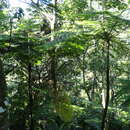Comprehensive Description
provided by North American Flora
Cyathea arborea (L.) Smith, Mem. Acad. Turin 5 : 417. 1793
Polypodium arboreum ,. Sp. PI. 1092, 1753. Disphenia arborea Presl, Tent. Pterid. ^d. 1836. Hemitelia arborea F^e, M#m. Foug. 5 : 350. 1852.
Caudex erect, 4—12 meters high, the fronds usually in a close divaricate crown, articulate and readily separable, the caudex with about 8-10 ranks of close-set to tessellate, oval, roundedovate, obovate, or broadly subhexagonal, scabrous scars about 2-4 cm. in diameter. or in young or rapidly growing plants the fronds strictly ascending, the stipes long-adnate, leaving a few distant elongate -elliptic scars up to 15-18 cm. long and about 4 cm. broad, or both types of scars evident in zones in the same individual ; summit of the caudex, the spaces among the upper scars, and the bases of the stipes closely covered with lanceolate attenuate dirty-white scales up to 4 cm. long; fronds 2.5^ meters long, the stipe very stout, low-tuberculate, yellowish-olivaceous, lighter above, succulent ; lamina 2-3 meters long, tripinnate, the primary and secondary rachises more or less muricate, dull-yellowish, minutel}'furfuraceo-puberulous, quickly glabrescent, devoid of scales, the leaf-tissue light-
^
green, delicately chartaceo-membranous, minutely papillate ; pinnae mostly alternate, spreading, 40-80 cm. long, 16-35 cm. broad, oblong, abruptly acuminate, petiolate (1-3 cm,) or the basal ones exactly ovate and longpetiolate {up to 7 cm.) ; pinnules of the middle pinnae 20-26 pairs, all but the lower ones sessile (in the lower and basal pinnae these longpetiolate, up to 1.5 cm.), subimbricate, contiguous, or mostly approximate, spreading (or the lower ones somewhat retrorse), 8-18 cm. long, 1.5-3.5 cm. broad, lanceolate, oblonglanceolate, or elliptic-lanceolate, usually broadest near the middle, the apex gradually longattenuate and serrate, the costa finely furfuraceo-puberulous below but quickly glabrous, above scantily long-pilose; segments 20-32 pairs, linear-oblong (or if partially fertile often narrowly oblong-spatulate), subfalcate, dilatate, sharply and often deeply serrate, if very fertile the margin usually revolute, each tooth embracing a sorus ; costules glabrous above, or with 1-3 spinous hairs near the apex, below uniformly with 1 or 2 deciduous white bullate scales at the base, elsewhere (together with the veins) very minutely glandularsetulose ; veins 10-13 pairs, if fertile mostly once-forked below the middle, if sterile often 2or3-forked; sori numerous, 6-11 pairs ; indusia lightor yellowish-brown, shallow, saucerlike ; receptacle capitate, exserted, squamulose-setiferous, sometimes cleft.
Type locality : I^e Morne de la Calebasse, Martinique.
Distribution : General in the Greater and Lesser Antilles ; rare in Mexico ; variously reported from northern South America and intervening territory.
- bibliographic citation
- Lucien Marcus Underwood, Ralph Curtiss BenedictWilliam Ralph Maxon. 1909. OPHIOGLOSSALES-FILICALES; OPHIOGLOSSACEAE, MARATTIACEAE, OSMUNDACEAE, CERATOPTERIDACEAE, SCHIZAEACEAE, GLEICHENIACEAE, CYATHEACEAE (pars). North American flora. vol 16(1). New York Botanical Garden, New York, NY
Cyathea arborea: Brief Summary
provided by wikipedia EN
Cyathea arborea (vernacular English: West Indian treefern, vernacular Spanish: helecho gigante or palo camarón) is a plant of the family Cyatheaceae in the order Cyatheales.
- license
- cc-by-sa-3.0
- copyright
- Wikipedia authors and editors

